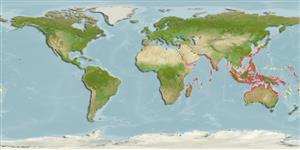Klassifizierung / Names
Namen | Synonyme | Catalog of Fishes(Gattung, Arten) | ITIS | CoL | WoRMS | Cloffa
Environment: milieu / climate zone / depth range / distribution range
Ökologie
seewasser riff-verbunden; standorttreu; tiefenbereich 1 - 15 m (Ref. 90102). Tropical; 22°C - 27°C (Ref. 130643)
Indo-West Pacific: Red Sea and southern Oman south to Natal, South Africa and east to the western Pacific where it occurs from Japan to northern Australia.
Size / Gewicht / Alter
Maturity: Lm ? range ? - ? cm
Max length : 9.0 cm TL Männchen/unbestimmt; (Ref. 4329)
Rückenflossenstacheln (insgesamt) : 8; Rückenflossenweichstrahlen (insgesamt) : 9; Afterflossenstacheln: 2; Afterflossenweichstrahlen: 8. Characterized by having dorsal fin rays VII-I, 9; anal fin rays II,8; pectoral fin rays 16; pelvic fin rays I, 5; pored lateral line scales 23-24; predorsal scales 3; circumpeduncular scales 12 (Ref. 93839); coppery brown to yellowish with an oblique black line below eye; may have three faint, dusky bars on sides (Ref. 2334, 48635); characterized further by the following: irregular whitish bar across anterior caudal peduncle; lower gill cover with dark brown patch; narrow, oblique dark band below eye; yellowish fins; first dorsal fin with dark brown tip; greatest depth of body 2.5-2.8 in SL (Ref. 90102).
Found in shallow protected coastal reef crests and lagoons, hiding below corals during the day, but also trawled on soft bottom (Ref. 48635); also under boulders on shallow reef flats. Nocturnal species. Aquarium breeding is possible (Ref. 130643).
Life cycle and mating behavior
Geschlechtsreife | Fortpflanzung | Ablaichen | Eier | Fecundity | Larven
Mouthbrooders (Ref. 240). Distinct pairing during courtship and spawning (Ref. 205).
Randall, J.E., G.R. Allen and R.C. Steene, 1990. Fishes of the Great Barrier Reef and Coral Sea. University of Hawaii Press, Honolulu, Hawaii. 506 p. (Ref. 2334)
IUCN Rote Liste Status (Ref. 130435: Version 2024-1)
Bedrohung für Menschen
Harmless
Nutzung durch Menschen
Fischereien: kommerziell; Aquarium: Kommerziell
Tools
Zusatzinformationen
Download XML
Internet Quellen
Estimates based on models
Preferred temperature (Ref.
123201): 24.6 - 29.3, mean 28.3 °C (based on 2805 cells).
Phylogenetic diversity index (Ref.
82804): PD
50 = 0.5000 [Uniqueness, from 0.5 = low to 2.0 = high].
Bayesian length-weight: a=0.01778 (0.00980 - 0.03226), b=3.16 (3.00 - 3.32), in cm total length, based on LWR estimates for this species & (Sub)family-body (Ref.
93245).
Trophic level (Ref.
69278): 3.4 ±0.5 se; based on size and trophs of closest relatives
Widerstandsfähigkeit (Ref.
120179): hoch, Verdopplung der Population dauert weniger als 15 Monate. (Preliminary K or Fecundity.).
Fishing Vulnerability (Ref.
59153): Low vulnerability (10 of 100).
Nutrients (Ref.
124155): Calcium = 163 [80, 279] mg/100g; Iron = 1.06 [0.59, 1.88] mg/100g; Protein = 18.6 [17.4, 19.8] %; Omega3 = 0.12 [0.06, 0.23] g/100g; Selenium = 28.7 [13.7, 58.7] μg/100g; VitaminA = 58.5 [16.7, 209.3] μg/100g; Zinc = 1.89 [1.20, 2.89] mg/100g (wet weight);
